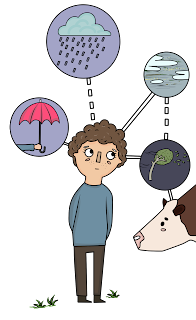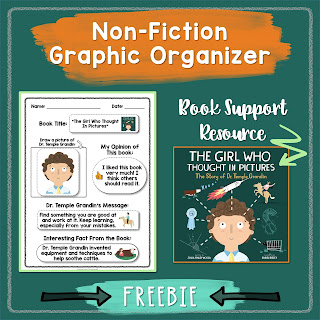(This blog post
contains affiliate links, from which I receive a small commission.)
I first became aware Grandin’s work early in my career as I
worked toward my Master’s degree in education. I was working in an autism
program at the time and found Grandin’s books fascinating. I read “Emergence: Labeled Autistic,” followed by "Thinking in Pictures: Other Reports from My Life with Autism." I was quickly drawn into her world. For the first time, I was better
able to understand the children I had been working with.
These students behaved differently because they thought differently. They thought differently because they were different, and therefore should be taught differently.
These students behaved differently because they thought differently. They thought differently because they were different, and therefore should be taught differently.
It was then that I realized that schools had been doing an
enormous disservice to students with autism. We can’t force children to think
the way we think they should. We shouldn’t squash down their strengths just
because they’re different from the norm. And we absolutely shouldn’t dismiss or
underestimate a child just because they speak, act, or think differently. We need to go beyond autism awareness and move towards autism acceptance.
And yet this is exactly what happens sometimes, especially with children on the autism spectrum.
These children are in our classroom because they have special needs, or rather, different needs. If a student has special needs, we need to provide an individual education program to fit those needs.
And yet this is exactly what happens sometimes, especially with children on the autism spectrum.
These children are in our classroom because they have special needs, or rather, different needs. If a student has special needs, we need to provide an individual education program to fit those needs.
So then, what’s the problem? Well, as Grandin points out, some education
programs are not quite meeting the needs of students with autism. They're so
caught up with testing and standards and peer comparisons that they are missing
out on their students’ strengths and needs. Grandin was quoted saying that “rigid
academic and social expectations could wind up stifling a mind that, while it
might struggle to conjugate a verb, could one day take us to distant stars.” We're shortchanging our students if we give them a one-size-fits-all education
and judge their progress only by test scores and peer comparisons.
An excerpt from Temple Grandin’s website: “Parents get so
worried about the deficits that they don’t build up the strengths, but those
skills could turn into a job,” said Grandin, who addresses scientific advances
in understanding autism in her newest book, The Autistic Brain: Thinking Across the Spectrum. "These kids often have uneven skills. We need to be a lot
more flexible about things. Don’t hold these math geniuses back. You’re going
to have to give them special ed in reading because that tends to be the
pattern, but let them go ahead in math.”
It seems that so many teachers and parents are trying to force children with autism into some kind of mold… a mold they may never comfortably fit into. This is exactly why special education exists. These kids don't need the same thing as everyone else. They need education that is individualized specifically for their needs.
It seems that so many teachers and parents are trying to force children with autism into some kind of mold… a mold they may never comfortably fit into. This is exactly why special education exists. These kids don't need the same thing as everyone else. They need education that is individualized specifically for their needs.
Having admired Dr. Temple Grandin for so many years, I was
thrilled at the opportunity to partner up with Innovation Press to create
resources for the new children’s book “The Girl Who Thought in Pictures: The Story of Temple Grandin,” by Julia Finley Mosca. I immediately read it to my
own children and they loved it as much as I did. In fact, later in the day, I
caught my boys wearing their book bags around the house overflowing with
stuffed animals. When I asked them what they were doing, my older son told me that they were squeezing their animals into the book bags “to comfort them,” modeling after an idea in Temple
Grandin’s story. He was so inspired by
her story, he spent the day drawing animals and chattering about how we could
invent things to help them.
 |
| Kind of cute, right? |
We spoke about how some people think differently and that
Temple Grandin says she thinks in pictures. I told my children that she
struggled in school because she was different from the other kids, but later
grew up to be a successful woman. She went from being a nonverbal child to a
famous motivational speaker. She had a difficult time in early on in school,
but later received three college degrees, including a doctorate. She built up
her strengths and interests to become a published animal activist, an autism advocate,
and an inventor. Temple Grandin set her sights and achieved her goals and
encourages others on the spectrum to do the same.
 I explained to my children that Grandin thought differently and saw the world from a different point of view. Because she felt that she
understood how animals thought and acted, she was able to design machinery and
techniques to help them. She felt that the techniques and equipment used at the
time was scaring and harming the animals. She wanted to create machinery and
techniques to help corral cattle in a more humane way. She used her different
way of thinking to improve living conditions for livestock.
I explained to my children that Grandin thought differently and saw the world from a different point of view. Because she felt that she
understood how animals thought and acted, she was able to design machinery and
techniques to help them. She felt that the techniques and equipment used at the
time was scaring and harming the animals. She wanted to create machinery and
techniques to help corral cattle in a more humane way. She used her different
way of thinking to improve living conditions for livestock. My older son spoke up and said, “She sounds smart. I’m glad she learned to use her thoughts.” His comment cracked me up, but I realized that he was right. That’s exactly what she did. She didn’t push away her tendencies and interests because they were different from her peers. She worked at them, pursued them, and strengthened her skills. Had she been forced to squash down those strengths, Temple Grandin’s accomplishments in her fields surely would have been limited. If she had been forced to learn and do things like her peers, her potential would have been stifled.
As a self-contained special education teacher, I’ve always
tried to encourage my students to find their strengths instead of focusing on
their weaknesses. Too often in special education, teachers and parents focus on
what students can’t do, won’t do, and never did. How can we expect them to rise
up when all we do is attach labels, site statistical averages, and compare them
to others? Why attach that weight to the foot of a struggling student? Not
every child will learn or progress in exactly the same way, so these standards
and expectations can be unfair to children who are differently-abled.
Instead of pushing autistic tendencies away, Grandin urges
parents and teachers to allow these characteristics to flourish. In her TED
Talk, she says that “The world needs all kinds of minds.” After all, it is with
different points of views that we take on new territory, create new inventions,
and come up with new concepts. Diverse learners are invaluable to our world and
it is our job to help them succeed.
My brand name is Exceptional Thinkers. I chose this title
because, while it is clearly a nod to special education, it does not imply a
deficit, a problem, or even a disability. “Different but not less” is a quote
that Grandin uses in her books and speeches. It is a powerful saying and it
speaks to my outlook on special education. Just because a child learns
differently does not mean that they are less capable. The word “exceptional”
simply means different from the norm, but it can also be used to mean brilliant
and outstanding. A child with special needs can be all of these things due to
their different way of thinking.
This month marks one year for Exceptional Thinkers on TPT (yay!) and I still love the name, maybe more than ever.
This month marks one year for Exceptional Thinkers on TPT (yay!) and I still love the name, maybe more than ever.
“The Girl Who Thought in Pictures” is a picture book for
children that tells Grandin’s story while instilling the idea that we must find
our strengths and work at them in order to succeed. I was thrilled when I found
out that I was chosen to create resources for this book and decided that it
only made sense to design activities that could be used with diverse learners. In
my store, you’ll find two resources related to Temple Grandin: one FREE download, and one paid (but inexpensive!) one.
The free resource is a differentiated story graph designed to be used with "The Girl Who Thought in Pictures." I also offer a larger resource that includes a reading passage about Grandin along with a character graph, flip book activity, and writing prompts that can be used with or without the book.
I designed these activities to be used with a diverse group of students. Students who are nonverbal or have limited writing ability would benefit from the cut/ paste picture answer choices, while typically developing peers could write out their answers directly onto the activity sheets. So if you're interested in any of that, here ya go:
The free resource is a differentiated story graph designed to be used with "The Girl Who Thought in Pictures." I also offer a larger resource that includes a reading passage about Grandin along with a character graph, flip book activity, and writing prompts that can be used with or without the book.
I designed these activities to be used with a diverse group of students. Students who are nonverbal or have limited writing ability would benefit from the cut/ paste picture answer choices, while typically developing peers could write out their answers directly onto the activity sheets. So if you're interested in any of that, here ya go:
Visit my blog at https://teachingexceptionalthinkers.com/ for more fun teaching ideas!


























































